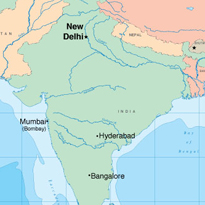Roll credits ….
Thursday afternoon
Sleep deprivation addressed: Check. E-mail caught up: Check. Jet-lag cured: Let’s just say we’re working on it.
Still, after a good night’s sleep, a happy reunion with my wife and our three dogs and a little red meat I’m well on my way back to normal.
Now that a little time and distance has passed since I left amazing India behind (for now), I wanted to wrap up the blog with a few final thoughts on our 11 days in this interesting and complex place.
Like most places, I suspect, India is much more than what one sees on TV or reads in the newspaper; far greater than the sum of the stereotypical images we too often are fed here in the U.S.
To be sure, we witnessed extreme poverty and experienced traffic that will add gray or subtract hair from one’s head. We also saw our fair share of cows, goats and even the stray camel or two along the road. And, yes, we were counseled against drinking the water.
We also breezed through modern airports in places such as Bangalore and Delhi and witnessed a tech-driven building boom in Hyderabad that any state in the U.S. would die for. We ate wonderful local food (too much of it at times) and were treated like royalty everywhere we went. On our one day off we took in the grandeur of the Taj Mahal, which was worth every minute of the 2-hour train ride each way – and the 3-hour delay in leaving Agra that resulted in us not getting back to our hotel until nearly 2 a.m.
Beyond that, we met people deeply committed to the same things we want at Indiana University: To produce more college graduates and to provide those graduates with the tools they need to succeed in the global world of tomorrow. IU has a lot to offer its counterparts in Indian higher education circles, but rest assured it’s a two-way street. I have no doubt we could learn a few things along the way, too.
I know I’ve written about this at some length already but the magnitude of the issues facing India as result of its sheer size can’t be overstated. A little perspective: We visited four cities whose populations are greater than the entire state of Indiana. By some estimates, India needs to add more than 800 universities in the next decade to have a shot at increasing the percentage of citizens going to college from its current 15 percent to around 25 percent. That’s more than the total number of public universities in the U.S. today.
In some ways, India is a big, messy place with big problems. It’s also a place filled with big ideas and the economies of scale to foster big positive change. It’s sensory overload in every aspect: the sights and sounds, the possibilities and the challenges. One thing it’s not is dull.
—
Before I officially turn the lights off on our India blog, a few thanks are in order to the people who made this trip a success and who in one way or another contributed to my musings. Any mistakes made in my posts are solely my fault and not that of anyone who provided information and assistance.
For starters, a guy couldn’t ask for better traveling partners than those who made this trip. If you ever get the chance to go to India, do it. If you ever get the chance to go with a collection of scholars, do your best to sit as close to them on the bus as possible and soak in every word. I felt smarter just being around this group and their opinions, facts and ideas were very much appreciated.
Our Alumni Association does an outstanding job every day connecting IU’s 500,000 alumns to their alma mater and Eric DeHaan, director of international affairs for IUAA did a superb job setting up two alumni events in India for us.
Our department of International Affairs, led by Vice President David Zaret, was responsible for defining the scale and scope of this trip with the help of our India scholar Sumit Ganguly whose connections proved invaluable in setting up meetings.
In 11 days, we signed five new partnership agreements; met with five prominent Indian politicians, including the vice president; had meetings with four of India’s largest and most successful businesses and set the table for future growth in the country through several other meetings, dinners and events. I’d say we got our money’s worth.
Not only is Laurie McRobbie, IU’s first lady, an outstanding representative for the university she also has my eternal thanks for helping me select a handmade rug in Agra that scored major points with my wife.
A special thanks goes to Shawn Reynolds. Shawn’s day job is as Executive Director of International Partnerships and Strategic Initiatives and he played a major role in setting the agenda for our trip. In India, he also was our CLO – Chief Logistics Officer . Shawn, who is the definition of unflappable, herded the cats and kept track of a dizzying number of travel and meeting details. Not once were we late or did we get lost under his watch.
He also gets credit for my single favorite line of the trip. When asked by one of the members of our group exactly where Infosys was located in Bangalore, Shawn just smiled and said: “It is where it is.” I like a little Zen with my travel.
Finally, President McRobbie deserves major kudos for having the vision to demand that IU aspire to be a world-class university and for backing his words up with a significant commitment of time and energy. His message at each stop on our trip was powerful and on point, and he assembled the right people to ensure we made the most of our time in India.
With that, I will just say Alavidā and thanks for spending a little time with us on our journey through India.
No Comments
No comments. Be the first.
Sorry, the comment form is closed at this time.



